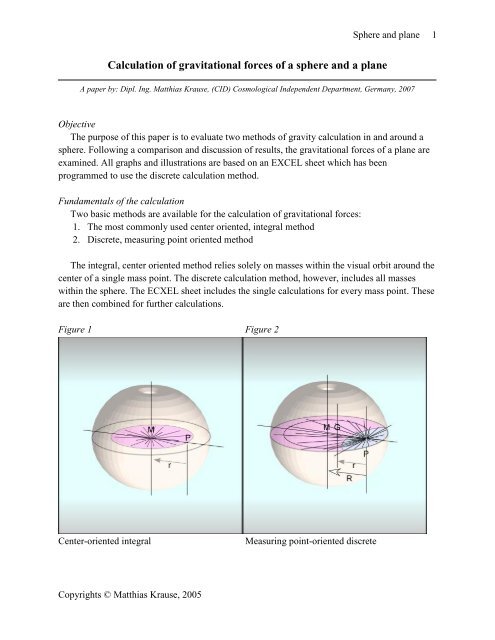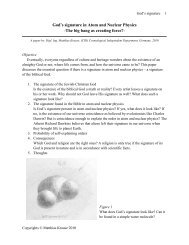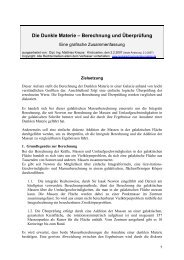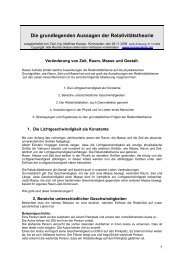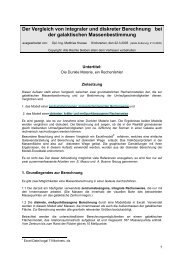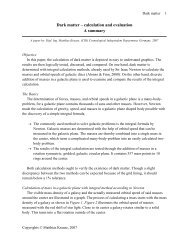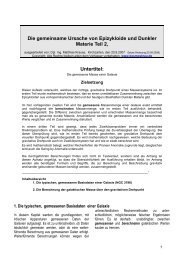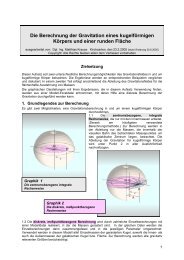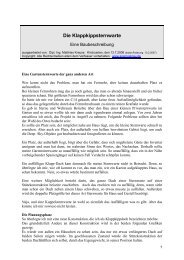Calculation of gravitational forces of a sphere and ... - Dunkle-Materie
Calculation of gravitational forces of a sphere and ... - Dunkle-Materie
Calculation of gravitational forces of a sphere and ... - Dunkle-Materie
Create successful ePaper yourself
Turn your PDF publications into a flip-book with our unique Google optimized e-Paper software.
<strong>Calculation</strong> <strong>of</strong> <strong>gravitational</strong> <strong>forces</strong> <strong>of</strong> a <strong>sphere</strong> <strong>and</strong> a plane<br />
Copyrights © Matthias Krause, 2005<br />
Sphere <strong>and</strong> plane 1<br />
A paper by: Dipl. Ing. Matthias Krause, (CID) Cosmological Independent Department, Germany, 2007<br />
Objective<br />
The purpose <strong>of</strong> this paper is to evaluate two methods <strong>of</strong> gravity calculation in <strong>and</strong> around a<br />
<strong>sphere</strong>. Following a comparison <strong>and</strong> discussion <strong>of</strong> results, the <strong>gravitational</strong> <strong>forces</strong> <strong>of</strong> a plane are<br />
examined. All graphs <strong>and</strong> illustrations are based on an EXCEL sheet which has been<br />
programmed to use the discrete calculation method.<br />
Fundamentals <strong>of</strong> the calculation<br />
Two basic methods are available for the calculation <strong>of</strong> <strong>gravitational</strong> <strong>forces</strong>:<br />
1. The most commonly used center oriented, integral method<br />
2. Discrete, measuring point oriented method<br />
The integral, center oriented method relies solely on masses within the visual orbit around the<br />
center <strong>of</strong> a single mass point. The discrete calculation method, however, includes all masses<br />
within the <strong>sphere</strong>. The ECXEL sheet includes the single calculations for every mass point. These<br />
are then combined for further calculations.<br />
Figure 1 Figure 2<br />
Center-oriented integral Measuring point-oriented discrete
Copyrights © Matthias Krause, 2005<br />
Sphere <strong>and</strong> plane 2<br />
The calculation <strong>and</strong> comparison <strong>of</strong> results occur in a <strong>sphere</strong> with 5056 mass points (a plane<br />
with 357 mass points). Hence, starting from the center, each has 10 measuring points. Similar<br />
results are to be expected when the different methods are compared. A slight discrepancy caused<br />
by the nature <strong>of</strong> discrete calculation will occur, however, it should remain within single digit<br />
percent values.<br />
Derivation <strong>of</strong> gravity with the center-oriented, integral method according to Alonso <strong>and</strong> Finn<br />
(2000)<br />
Students should be familiar with the calculation model, as it is portrait in every science school<br />
book. Alonso <strong>and</strong> Finn (2000) derive the formula for <strong>gravitational</strong> <strong>forces</strong> in the following way:<br />
The formulas concerning <strong>gravitational</strong> <strong>forces</strong> pertain to single masses only. When<br />
determining the <strong>forces</strong> between planets <strong>and</strong> the sun, for example, the diameter <strong>of</strong> the<br />
planets is insignificantly small compared to the vast distances between them.<br />
Consequently, they can be used as single masses. Nevertheless, with a relatively short<br />
distance, the volumes <strong>and</strong> <strong>gravitational</strong> <strong>forces</strong> within the planets or <strong>sphere</strong>s need to be<br />
included. Even Newton himself was unsure <strong>of</strong> how to accomplish this <strong>and</strong> postponed<br />
the publication <strong>of</strong> his works until he had found a solution - almost two decades later.<br />
The <strong>gravitational</strong> <strong>forces</strong> between two masses are calculated with:<br />
Figure 3<br />
(F1)<br />
The ideal hollow <strong>sphere</strong><br />
center<br />
<strong>Calculation</strong> <strong>of</strong> the<br />
<strong>gravitational</strong> field for a<br />
point outside <strong>of</strong> a mass<br />
that is evenly<br />
distributed over a<br />
hollow <strong>sphere</strong>
Copyrights © Matthias Krause, 2005<br />
Sphere <strong>and</strong> plane 3<br />
The calculation <strong>of</strong> a hollow <strong>sphere</strong>’s <strong>gravitational</strong> field usually occurs with the help <strong>of</strong><br />
an outside mass P <strong>and</strong> the division <strong>of</strong> the <strong>sphere</strong>’s surface into narrow strips. The<br />
center <strong>of</strong> these strips lies on the line between A <strong>and</strong> B, with the radius <strong>and</strong><br />
the width . Consequently, the surface <strong>of</strong> each strip is: length x width or<br />
With m being the combined mass <strong>of</strong> the <strong>sphere</strong>, the mass per surface unit is <strong>and</strong><br />
the mass <strong>of</strong> each strip is<br />
The points <strong>of</strong> each strip are at an equal distance R from the point P. Hence, the<br />
<strong>gravitational</strong> potential <strong>of</strong> the strips on the point P is:<br />
.<br />
(F1.1)<br />
According to Figure 3, which means r <strong>and</strong> a are constant.<br />
which leads to<br />
(F2)<br />
For the integral determination <strong>of</strong> the whole potential for the <strong>sphere</strong> surface, the borders<br />
for R are set as <strong>and</strong> .<br />
for all (F3)<br />
If the point P is located within the <strong>sphere</strong>, the calculation looks as followed:
Figure 4<br />
Copyrights © Matthias Krause, 2005<br />
Sphere <strong>and</strong> plane 4<br />
<strong>Calculation</strong> <strong>of</strong> the <strong>gravitational</strong> field for a point P inside <strong>of</strong> the ideal hollow <strong>sphere</strong><br />
The potential <strong>of</strong> the <strong>sphere</strong> with the radius R between <strong>and</strong> is<br />
for (F4)<br />
This constant value is independent from the location <strong>of</strong> point P. The modification <strong>of</strong><br />
(F1) leads to the formulas for the field force on the points outside <strong>of</strong> the <strong>sphere</strong> surface<br />
<strong>and</strong> on the inside<br />
The ideal hollow <strong>sphere</strong><br />
center<br />
A comparison <strong>of</strong> (F3) <strong>and</strong> (F5) shows<br />
for all (F5)<br />
for all (F6)<br />
Figure The field 5 force <strong>and</strong> potential <strong>of</strong> masses are equal for a mass that is distributed<br />
Won’t evenly copy on the over!! surface Ask <strong>and</strong> for original a mass that is inside <strong>of</strong> a <strong>sphere</strong>. For all points P inside<br />
<strong>of</strong> a hollow <strong>sphere</strong>, the field force is 0, <strong>and</strong> the energy is constant.
Figure 5<br />
Copyrights © Matthias Krause, 2005<br />
Sphere <strong>and</strong> plane 5<br />
Differences <strong>of</strong> G <strong>and</strong> V as a function <strong>of</strong> distance from the center <strong>of</strong> a homogenously<br />
distributed mass on the surface <strong>of</strong> a <strong>sphere</strong><br />
Coming from the outside toward the center <strong>of</strong> the <strong>sphere</strong>, the potential remains<br />
constant when passing the boundary line <strong>of</strong> the <strong>sphere</strong>. (The slope, however, changes<br />
irregularly.) The gravity G changes immediately in accordance with formula (F5) <strong>and</strong><br />
falls until it reaches a zero value in the center.<br />
Gravity in <strong>and</strong> around a solid <strong>sphere</strong><br />
Figure 6<br />
The ideal solid <strong>sphere</strong><br />
center<br />
<strong>Calculation</strong> <strong>of</strong> a<br />
<strong>gravitational</strong> field for a<br />
point P outside <strong>of</strong> the<br />
solid <strong>sphere</strong>
Copyrights © Matthias Krause, 2005<br />
Sphere <strong>and</strong> plane 6<br />
The mass <strong>of</strong> a solid <strong>sphere</strong> is , if describes the mass density. Once<br />
the surface <strong>of</strong> the <strong>sphere</strong> is crossed, the force <strong>of</strong> the field is equal to .<br />
The same applies to the mass distribution in a solid plane. The calculation <strong>of</strong><br />
<strong>gravitational</strong> <strong>forces</strong> <strong>of</strong> <strong>sphere</strong> <strong>and</strong> plane are similar.<br />
Under the assumption that the <strong>sphere</strong> is completely solid <strong>and</strong> homogenous, we can<br />
treat it like a sum <strong>of</strong> thin layers. Each layer exerts a specific field force, which is<br />
determined with the formulas (F5) <strong>and</strong> (F6). Since, however, the slices have a<br />
common center, the distance r from P is the same in each calculation.<br />
Therefore, the result <strong>of</strong> formula (F5) applies, <strong>and</strong> the entire mass <strong>of</strong> the <strong>sphere</strong><br />
can be used as a single point mass in the center.<br />
Furthermore, the <strong>sphere</strong> does not have to be homogenous, as long as the<br />
distribution <strong>of</strong> its masses is <strong>sphere</strong> symmetrical <strong>and</strong> independent from its direction.<br />
Figure 7<br />
The ideal solid <strong>sphere</strong><br />
center<br />
Gravity calculation for a point P inside <strong>of</strong> a solid <strong>sphere</strong><br />
In order to determine the field force within a homogenous solid <strong>sphere</strong>, point P is<br />
located at a distance to the <strong>sphere</strong>’s center that is smaller than its radius: . The
Copyrights © Matthias Krause, 2005<br />
Sphere <strong>and</strong> plane 7<br />
<strong>sphere</strong> slices beyond point P do not contribute to the field force on P. The slices<br />
between the center <strong>and</strong> P combined deliver a force equal to formula (F5). If m’ is the<br />
mass <strong>of</strong> the <strong>sphere</strong> with the radius r, the field force in P is:<br />
Figure 8<br />
(F7)<br />
The graph in Figure 8 illustrates the differences in G in a solid homogenous <strong>sphere</strong> as<br />
function from the distance to the <strong>sphere</strong>’s center.<br />
With the volume <strong>of</strong> a <strong>sphere</strong> defined as , the mass m’ can be calculated<br />
with<br />
’= .<br />
The <strong>gravitational</strong> force or field force within a <strong>sphere</strong> is calculated with<br />
Consequently, the field force within a homogenous <strong>sphere</strong> depends directly on the<br />
distance from its center (see Figure 8).<br />
At this point, Alonso <strong>and</strong> Finn (2000) leave it up to the reader to see that the gravity<br />
potential on a point outside <strong>of</strong> the <strong>sphere</strong> determined with (F4) weighs heavier into any<br />
calculation than that <strong>of</strong> a point on the inside.<br />
for all<br />
Even though errors occur if the examined body has a different symmetry, Alonso <strong>and</strong><br />
Finn (2000) conclude that regardless <strong>of</strong> any problems with <strong>sphere</strong> symmetry, the main
Copyrights © Matthias Krause, 2005<br />
Sphere <strong>and</strong> plane 8<br />
point is to underst<strong>and</strong> that the <strong>gravitational</strong> characteristics <strong>of</strong> a homogenous <strong>sphere</strong><br />
depend on the distance <strong>of</strong> P to the <strong>sphere</strong>’s center. The solution <strong>of</strong> any other problems<br />
pertaining to gravity calculation is <strong>of</strong>ten a symmetry adjustment. Such a simplification<br />
usually turns the issue into an easy to solve math problem.<br />
Alonso <strong>and</strong> Finn’s conclusion<br />
The purpose <strong>of</strong> these calculations <strong>and</strong> derivations is to see if the formulas for<br />
<strong>gravitational</strong> <strong>forces</strong> apply to point masses as well as masses with a larger volume.<br />
All formulas pertaining to the calculation <strong>of</strong> <strong>gravitational</strong> <strong>forces</strong> are valid for<br />
point masses <strong>and</strong> masses with volume – under specific circumstances. Spheres<br />
can be used as point masses if only the masses within the orbit <strong>of</strong> P are<br />
considered. The masses beyond this orbit shall not be used. In addition, a <strong>sphere</strong><br />
has to be rotation symmetrical.<br />
Hence, m <strong>and</strong> r are known variables <strong>and</strong> can be used to determine F.<br />
Derivation <strong>of</strong> gravity with the measuring point-oriented discrete calculation method<br />
When calculating discretely, a few fundamental evaluations can provide new insight <strong>and</strong><br />
underst<strong>and</strong>ing <strong>of</strong> <strong>gravitational</strong> <strong>forces</strong>. Alonso <strong>and</strong> Fin (2000) introduced two <strong>of</strong> their results,<br />
which have been summarized on the last four pages:<br />
1. In the center <strong>of</strong> a point symmetrical, solid, homogenous <strong>sphere</strong> gravity is not noticeable.<br />
2. As long as the masses on the surface <strong>of</strong> a hollow <strong>sphere</strong> are distributed evenly, the<br />
gravity on the inside is equal to zero.<br />
What happens when the masses are not symmetrical?<br />
1. Gravity in the center <strong>of</strong> a point symmetrical <strong>sphere</strong><br />
The ideal solid <strong>sphere</strong><br />
center<br />
Figure 9<br />
A point P is located in the center <strong>of</strong> a point<br />
symmetrical <strong>sphere</strong> shaped body. The mass<br />
distribution is even. The <strong>gravitational</strong> <strong>forces</strong> <strong>of</strong><br />
the surrounding masses counteract each other,<br />
as long as they have the same distance from the<br />
center <strong>and</strong> are exactly opposite each other.<br />
Consequently, the gravity in the center is<br />
completely cancelled out.
Copyrights © Matthias Krause, 2005<br />
Sphere <strong>and</strong> plane 9<br />
Figure 10<br />
The ideal solid <strong>sphere</strong><br />
When moving point P toward the edge <strong>of</strong> the<br />
<strong>sphere</strong>, the cancellation <strong>of</strong> <strong>gravitational</strong> <strong>forces</strong><br />
center<br />
remains the same, as long as the masses have<br />
the same distance from point P <strong>and</strong> are exactly<br />
opposite each other. P is in the center <strong>of</strong> a lens<br />
shapes body that is free <strong>of</strong> gravity (only<br />
pertaining to P). This shape is symmetrical to<br />
the line that runs through P <strong>and</strong> is orthogonal<br />
to the radius <strong>of</strong> the <strong>sphere</strong>, as shown in a<br />
darker shade <strong>of</strong> gray. The height <strong>of</strong> the body is<br />
. The subtraction <strong>of</strong> the lens shaped body from the <strong>sphere</strong> leaves a sickle shaped body that<br />
exerts <strong>gravitational</strong> <strong>forces</strong> onto point P. It is located to the left <strong>of</strong> the lens shaped body. Clearly,<br />
the masses influential to P are not symmetrical anymore; therefore, P is subjected to gravity.<br />
Surprisingly, the radius r <strong>and</strong> the mass m <strong>of</strong> the <strong>sphere</strong> are now irrelevant for further gravity<br />
calculations, as they are part <strong>of</strong> the gravity free lens. Of importance is only the sickle shaped<br />
body.<br />
(Compare to the results <strong>of</strong> the integral calculation by Alonso <strong>and</strong> Finn, where r <strong>and</strong> m are<br />
substantial for the determination <strong>of</strong> gravity.)<br />
2. Gravity on the inside <strong>of</strong> a hollow <strong>sphere</strong><br />
According to the integral calculation method, the inside <strong>of</strong> a hollow <strong>sphere</strong> is free <strong>of</strong> gravity.<br />
Figure 11 displays a hollow <strong>sphere</strong> centered within a solid <strong>sphere</strong>. The hollow (mass free) <strong>sphere</strong><br />
is big enough to allow a full orbit <strong>of</strong> point P around its center. In addition, Figure 11 shows the<br />
<strong>gravitational</strong> <strong>forces</strong> <strong>and</strong> radius. The radius r from the integral method has been turned into r vis.,<br />
because the inner orbits <strong>of</strong> P are only visual orbits.<br />
After evaluating the schematic illustration <strong>of</strong> all orbits <strong>and</strong> graphs, it should be clear that only the<br />
mass <strong>of</strong> the sickle shaped body outside <strong>of</strong> the hollow <strong>sphere</strong> exerts gravity on point P. The force<br />
<strong>of</strong> this gravity shall not be determined in this context. This is done <strong>and</strong> thoroughly explained in<br />
the “many-body problem in the calculation <strong>of</strong> galaxies” by Krause (2005a). Instead <strong>of</strong> using the<br />
masses, the <strong>forces</strong> <strong>of</strong> all measuring points are added <strong>and</strong> combined in a single rotation point at a<br />
distance r grav. from point P. The following mass equivalent produces the desired results:<br />
r turns into r grav. (F8)
Figure 11<br />
Forces within <strong>and</strong><br />
outside <strong>of</strong> the <strong>sphere</strong><br />
with a completely<br />
homogenous mass<br />
distribution<br />
A hollow <strong>sphere</strong> within the ideal solid <strong>sphere</strong><br />
Copyrights © Matthias Krause, 2005<br />
Sphere <strong>and</strong> plane 10<br />
The discrete calculation cannot be done with a single formula. A body has to be divided in the<br />
largest possible number <strong>of</strong> single points. Such a grid lining produces a number <strong>of</strong> single<br />
calculations that need to be added for a result. Thanks to computers, this is easily done with an<br />
EXCEL data sheet. For the examples in this paper, the EXCEL program calculates with 5065<br />
mass points <strong>and</strong> 10 measuring points (+1 center point). The program has to determine the <strong>forces</strong><br />
<strong>of</strong> 5064 mass points on each <strong>of</strong> the measuring points, which leads to a sum <strong>of</strong> over 50,000 single<br />
calculations. Because <strong>of</strong> the gridding, the results are <strong>of</strong>f by about 1%, which is usually a<br />
tolerable discrepancy.
Figure 12<br />
Copyrights © Matthias Krause, 2005<br />
Sphere <strong>and</strong> plane 11<br />
The two graphs in Figure 12 represent the results <strong>of</strong> a hollow <strong>sphere</strong> (on the left) <strong>and</strong> a solid<br />
<strong>sphere</strong> calculation (on the right). The gravity on P on the inside as well as on the outside are<br />
illustrated. These results are similar to those determined with the integral center-oriented<br />
calculation method.<br />
The discrete measuring point-oriented <strong>and</strong> integral center-oriented calculation methods<br />
produce the same results for <strong>gravitational</strong> <strong>forces</strong> inside <strong>and</strong> outside a solid homogenous or<br />
hollow <strong>sphere</strong>.<br />
The labor, however, for the discrete calculation is more intense. Nevertheless, the discrete<br />
method leaves the option to change the masses within their symmetry. This produces mistakes in<br />
the integral calculation (…errors occur if the examined body has a different symmetry (p.7)).<br />
A comparison <strong>of</strong> both methods raises the question why the results are equal, even though the<br />
start variables (r, M) could not be more different.<br />
Comparison <strong>of</strong> mass increase in the two models<br />
Figure 13<br />
The two curves for the gravity exerting masses on<br />
P are very different in <strong>and</strong> around the solid<br />
<strong>sphere</strong>. The discretely determined mass values<br />
approach the absolute mass value, but never reach<br />
it - even on outside <strong>of</strong> the <strong>sphere</strong>, because the<br />
<strong>forces</strong> <strong>of</strong> masses at 180 counteract each other.<br />
Their counteraction changes depending on the<br />
angle. The integral curve reaches its maximum on<br />
the outside, where it is equal to the absolute mass<br />
<strong>of</strong> the <strong>sphere</strong>. Logically, with the different masses<br />
but equal results, the radius curves are different as<br />
well (Figure 14).
Figure 14<br />
Figure 15<br />
Comparison <strong>of</strong> radius size in the two<br />
models<br />
Comparison <strong>of</strong> visual orbital speed <strong>of</strong> P in the<br />
two models<br />
Copyrights © Matthias Krause, 2005<br />
Figure 14<br />
Sphere <strong>and</strong> plane 12<br />
The radius <strong>of</strong> the integral calculation<br />
increases steadily <strong>and</strong> indicates the<br />
distance between point P <strong>and</strong> the<br />
center <strong>of</strong> the <strong>sphere</strong>. The radius <strong>of</strong> the<br />
discrete calculation shows the distance<br />
between point P <strong>and</strong> the <strong>gravitational</strong><br />
rotation point <strong>of</strong> all relevant masses.<br />
This radius r grav is different from the<br />
visual radius g vis, because P moves on<br />
a libration track, not the <strong>gravitational</strong><br />
orbit. This libration orbit is only the<br />
visible orbit <strong>of</strong> P around the center <strong>of</strong><br />
the <strong>sphere</strong>.<br />
Consequently, any further calculation<br />
<strong>of</strong> these different values for mass <strong>and</strong><br />
radius produces different results, for<br />
example, the determination <strong>of</strong> the<br />
visual orbital speed <strong>of</strong> P around the<br />
center <strong>of</strong> the <strong>sphere</strong>.<br />
The speed <strong>of</strong> P calculated with the<br />
discrete method is greater at the edge<br />
<strong>of</strong> the <strong>sphere</strong> than that <strong>of</strong> the integral<br />
method.<br />
This does not change even if more<br />
mass is added to the <strong>sphere</strong>’s center<br />
<strong>and</strong> the masses are not distributed<br />
evenly anymore.
Copyrights © Matthias Krause, 2005<br />
Sphere <strong>and</strong> plane 13<br />
Summary<br />
A comparison <strong>of</strong> the two calculation methods reveals that they produce different results, with<br />
the exception <strong>of</strong> the <strong>gravitational</strong> force in a homogenous symmetrical <strong>sphere</strong>. Even though the<br />
integral calculation method is the easier <strong>and</strong> faster method, it has its limitation: The values for<br />
the <strong>gravitational</strong> force are only correct when the body is absolutely homogenous <strong>and</strong><br />
symmetrical.<br />
The discrete calculation method delivers correct results for any <strong>sphere</strong> symmetrical body,<br />
regardless <strong>of</strong> its mass distribution. In addition, the basis values for the gravity calculation (mass<br />
<strong>and</strong> radius) are different in either model, which means that any further calculation will most<br />
likely lead to different results.<br />
The discrete method has the advantage <strong>of</strong> using the <strong>gravitational</strong> orbit for its calculation <strong>of</strong> the<br />
visual orbital speed. Masses on either orbit take the same time for one complete rotation, but<br />
their speed is different, which has far reaching consequences. If the mass <strong>of</strong> a distant galaxy is<br />
determined over its visual orbital speed, the integral method delivers a result that is too big. This<br />
error in calculation is the basis for the crazy assumption that an invisible dark matter exists<br />
(Krause, 2005b).<br />
Why do both methods produce correct results for the gravity in a homogenous symmetrical<br />
<strong>sphere</strong>?<br />
The integral formula is based on two major mistakes. The mathematical steps are correct, but<br />
two errors in logic cause a faulty derivation. One <strong>of</strong> these errors is very field specific: The<br />
masses are combined over their potential V <strong>and</strong> not over their <strong>gravitational</strong> force G or F. Such a<br />
calculation ignores the direction <strong>of</strong> force until the formula is transformed into a vector formula<br />
with a common direction . (See (F4) in (F5) <strong>and</strong> (F6)). This transformation is incorrect,<br />
because the direction <strong>of</strong> force pertaining to point P cannot be derived from the formula for the<br />
potential.<br />
The following thorough examination <strong>of</strong> the formulas points out the mistake:<br />
The first error is done in formula (F1.1), where the <strong>gravitational</strong> force <strong>of</strong> a strip (F or G)<br />
(the gravity potential V) on point P is assumed to be too large. At this point, the<br />
counteraction <strong>of</strong> masses is not included in the calculation. The reduction <strong>of</strong> <strong>forces</strong> (<strong>of</strong> the<br />
potential) should have been done with the help <strong>of</strong> a parallelogram <strong>of</strong> <strong>forces</strong>. As P moves<br />
closer to the outside surface <strong>of</strong> the <strong>sphere</strong>, the angle ( ) between the masses grows.<br />
Consequently, the counteraction between masses increases (Figure 16).<br />
By neglecting this counteraction, the potential <strong>of</strong> each strip is set too high. A correct<br />
calculation can be found in the “Many-body problem” by Krause (2005a) in this forum.
Figure 16<br />
Copyrights © Matthias Krause, 2005<br />
Sphere <strong>and</strong> plane 14<br />
Only a part <strong>of</strong> the <strong>forces</strong> influences point P <strong>gravitational</strong>ly (illustrated by the blue<br />
arrows). The same applies to the lower half <strong>of</strong> the <strong>sphere</strong> <strong>and</strong> to the strips that are on the<br />
<strong>sphere</strong>. If, for example, P lies in the center <strong>of</strong> the strip (to the right), all the <strong>forces</strong><br />
counteract each other (G=0).<br />
The second mistake is located in<br />
formula (F3), where the <strong>forces</strong> are<br />
too small. The reason for this lies<br />
in the summarizing <strong>of</strong> potentials<br />
(<strong>forces</strong> <strong>of</strong> all strips) in the center <strong>of</strong><br />
<strong>sphere</strong> masses (blue circle in<br />
Figure 17), not in the <strong>gravitational</strong><br />
center <strong>of</strong> <strong>forces</strong> (pink circle in<br />
Figure 17). This mistake is<br />
specific to the field <strong>of</strong> gravity<br />
calculations as well. By combining<br />
the masses in the center <strong>of</strong> the<br />
<strong>sphere</strong>, the distance from P<br />
increases more than it would if the<br />
masses were combined in the<br />
<strong>gravitational</strong> center. r versus rgrav .<br />
Parallelogram <strong>of</strong> <strong>forces</strong> <strong>and</strong><br />
Figure 17<br />
Combination <strong>of</strong> mass strips <strong>and</strong> their gravity on<br />
pointP
Copyrights © Matthias Krause, 2005<br />
Sphere <strong>and</strong> plane 15<br />
Consequently, the potential is too small. How to add the single masses correctly is<br />
explained in the “Many-body Problem” by Krause (2005a).<br />
Both mistakes incidentally cancel each other out throughout the whole calculation. The<br />
end result is correct, even though the calculation is faulty.<br />
Due to the facts that the integral center-oriented method delivers different results than the<br />
discrete method in all parameters, <strong>and</strong> that it relies on a faulty calculation for the<br />
determination <strong>of</strong> <strong>gravitational</strong> <strong>forces</strong>, it is useless in the field <strong>of</strong> cosmic calculations.<br />
Derivation <strong>of</strong> gravity in a ‘hollow’ plane<br />
The derivation <strong>of</strong> gravity in a plane is possible with the help <strong>of</strong> the <strong>sphere</strong> model. The first<br />
step is to take an ideal hollow <strong>sphere</strong> with a homogenous mass distribution on its surface. The<br />
<strong>gravitational</strong> <strong>forces</strong> in the center <strong>of</strong> the <strong>sphere</strong> are nonexistent. Point P divides the <strong>sphere</strong> into<br />
two halves if a line orthogonal to r with the distance r is drawn through P. All the masses in the<br />
segment facing away<br />
from the center <strong>of</strong> the<br />
<strong>sphere</strong> exert a<br />
<strong>gravitational</strong> force that<br />
pulls P away from the<br />
center. This gravity<br />
shall be called negative<br />
gravity. The masses in<br />
the opposite <strong>sphere</strong><br />
segment pull P toward<br />
the center, which shall<br />
be called positive<br />
gravity. The positive<br />
<strong>and</strong> negative gravities<br />
are identical in<br />
strength, but pull P in<br />
opposite directions.<br />
The counteraction <strong>of</strong><br />
gravities results in a<br />
nonexistent gravity for<br />
point P.<br />
The ideal hollow<br />
<strong>sphere</strong><br />
Figure 18
Copyrights © Matthias Krause, 2005<br />
Sphere <strong>and</strong> plane 16<br />
The second step is to divide the <strong>sphere</strong> into thin horizontal planes. Two <strong>of</strong> these planes, which<br />
are in actuality only mass rings, are used for the following evaluation. One <strong>of</strong> the plane is the<br />
mid plane. The center <strong>of</strong> the <strong>sphere</strong> is also the center <strong>of</strong> this plane. The other plane is close to the<br />
top <strong>of</strong> the <strong>sphere</strong>. Its radius is smaller than that <strong>of</strong> the radius emminating from point P. The<br />
gravity <strong>of</strong> all planes combined on P is zero, since the hollow <strong>sphere</strong> is the sum <strong>of</strong> all planes.<br />
The <strong>gravitational</strong> <strong>forces</strong> pertaining to P within the small plane are directed toward the center,<br />
which is illustrated by the arrow pointing in. Consequently, P is exposed to a positive<br />
<strong>gravitational</strong> pull.<br />
The mid plane, however, pulls point P toward the center (pink) <strong>and</strong> toward the edge (blue).<br />
Which <strong>of</strong> these two <strong>forces</strong> in the mid plane is stronger? Since the sum <strong>of</strong> all <strong>forces</strong> on P is zero,<br />
the force <strong>of</strong> the mid plane on P must be negative (toward the edge). The reason for this is<br />
founded in the small plane. For the <strong>forces</strong> to add up to zero, <strong>and</strong> the small plane only exerting<br />
positive gravity, the mid plane’s gravity has to be negative.<br />
Figure 19<br />
Gravity in a plane<br />
Therefore, the gravity <strong>of</strong> different<br />
planes is unequal. Figure 19<br />
compares the <strong>forces</strong> <strong>of</strong> ten planes<br />
above <strong>and</strong> below the mid plane. The<br />
sum <strong>of</strong> their <strong>forces</strong> on P is zero.<br />
The mid plane with point P is<br />
represented by the pink curve.<br />
Clearly, the majority <strong>of</strong> planes exert<br />
positive gravity, while the pink (<strong>and</strong><br />
yellow) curve delivers the negative<br />
gravity to facilitate a combined<br />
force <strong>of</strong> zero. It should not be<br />
difficult to see that the calculation<br />
<strong>of</strong> gravity in a <strong>sphere</strong> cannot be<br />
transferred to a plane.<br />
A plane with its entire mass at its edge has different <strong>gravitational</strong> characteristics than a<br />
homogenous hollow <strong>sphere</strong>. While the gravity on a point P within the hollow <strong>sphere</strong> is zero,<br />
the gravity within a plane is negative (a point P is pulled to the edge).<br />
The negative gravity on P increases with a growing distance from the plane’s center.
Copyrights © Matthias Krause, 2005<br />
Sphere <strong>and</strong> plane 17<br />
Derivation <strong>of</strong> gravity in a ‘solid’ plane<br />
The derivation <strong>of</strong> gravity in a solid plane is similar to that <strong>of</strong> a hollow plane. The solid <strong>sphere</strong><br />
is divided into a number <strong>of</strong> thin planes. The mid plane with point P <strong>and</strong> a plane with a smaller<br />
radius than that <strong>of</strong> P<br />
are evaluated. Because Ideal solid <strong>sphere</strong><br />
<strong>of</strong> the homogenous<br />
mass distribution<br />
throughout the plane, it<br />
is easy to determine<br />
the mass needed to<br />
counteract the blue<br />
shaded area <strong>of</strong> negative<br />
gravity. The pink area<br />
separated by the blue<br />
dotted line together<br />
with the blue area<br />
shows the lens shape in<br />
which gravity on P is<br />
zero. Subtracting this<br />
lens from the rest <strong>of</strong><br />
the mid plane leaves an<br />
area <strong>of</strong> solely positive<br />
gravity on P, with a<br />
Figure 20<br />
<strong>gravitational</strong> center<br />
that is different from<br />
the center <strong>of</strong> the plane.<br />
Gravity in a plane<br />
Figure 21<br />
compares the <strong>forces</strong> <strong>of</strong> ten planes above<br />
<strong>and</strong> below the mid plane. The sum <strong>of</strong><br />
their <strong>forces</strong> on P in the solid <strong>sphere</strong> is<br />
linearly increasing as seen in Figure 12<br />
on the right side. The pink curve<br />
represents the mid plane with point P.<br />
The slope <strong>of</strong> gravity within a<br />
plane, however, is not linear like<br />
that <strong>of</strong> a solid <strong>sphere</strong>,<br />
because the neutral area decreases nonlinear<br />
as point P moves closer to the
Copyrights © Matthias Krause, 2005<br />
Sphere <strong>and</strong> plane 18<br />
edge. If the gravity on the outside <strong>of</strong> the solid mid plane is calculated discretely, it also<br />
decreases, but not equal to that <strong>of</strong> a solid <strong>sphere</strong>. The <strong>gravitational</strong> center (<strong>of</strong> the plane) lies<br />
closer to point P (discretely calculated) than the center <strong>of</strong> the plane. Consequently, the<br />
<strong>gravitational</strong> force on point P in a plane is much stronger than that in a <strong>sphere</strong>.<br />
Gravitational force on P calculated with discrete<br />
<strong>and</strong> integral method<br />
Figure 22<br />
The <strong>gravitational</strong> <strong>forces</strong> n a point P<br />
within <strong>and</strong> outside <strong>of</strong> a solid plane as<br />
calculated with integral <strong>and</strong> discrete<br />
methods have absolutely no<br />
similarities. The pink curve illustrates<br />
the gravity on a point P determined<br />
with discrete calculation, while the<br />
blue curve represents the results <strong>of</strong> an<br />
integral calculation.<br />
Comparison <strong>of</strong> gravity in the integral <strong>and</strong> discrete model<br />
While at least the results <strong>of</strong> the gravity calculation in <strong>and</strong> around a homogenous symmetrical<br />
<strong>sphere</strong> were equal, a comparison <strong>of</strong> integral <strong>and</strong> discrete method applied to a plane reveals that<br />
Figure 23<br />
Difference between integral <strong>and</strong><br />
discrete method in percent<br />
none <strong>of</strong> the values for gravity F, mass<br />
m, <strong>and</strong> radius r are similar. The<br />
enormous differences between the<br />
two methods are illustrated in Figure<br />
23.<br />
The 100% line represents the values<br />
<strong>of</strong> gravity determined with the<br />
integral method. The values above<br />
this line show the <strong>gravitational</strong> <strong>forces</strong><br />
for a point P at the edge <strong>of</strong> the plane<br />
determined with the discrete method,<br />
<strong>and</strong> the values below the 100% line<br />
st<strong>and</strong> for the <strong>forces</strong> for a point within<br />
the plane also determined with the<br />
discrete method. The single points in
Copyrights © Matthias Krause, 2005<br />
Sphere <strong>and</strong> plane 19<br />
Figure 23 represent different distances from the center <strong>of</strong> the plane, beginning on the left. At<br />
point 11, the highest marker, all masses in the discrete model exert <strong>gravitational</strong> force on P. (the<br />
grid lining prevents this in point 10). The red marker is the first point on the outside <strong>of</strong> the plane<br />
at a distance <strong>of</strong> 12, followed by 15, 30, 45, 60, <strong>and</strong> 100.<br />
The discretely determined values for the <strong>gravitational</strong> force close to the center <strong>of</strong> a<br />
homogenous field are considerably smaller than those calculated with the integral method.<br />
Once the point P is moved close to the edge <strong>of</strong> the plane, the values <strong>of</strong> the discrete method<br />
increase much faster <strong>and</strong> even double than those <strong>of</strong> the integral calculation. On the outside <strong>of</strong><br />
the plane, the values <strong>of</strong> the discrete calculation approach, but never reach the lower values <strong>of</strong><br />
the integral method.<br />
The integral values for the <strong>gravitational</strong> <strong>forces</strong> <strong>of</strong> a hollow <strong>and</strong> solid <strong>sphere</strong> are wrong.<br />
Further application <strong>of</strong> the discrete gravity calculation<br />
Three examples <strong>of</strong> the errors that occur with integral calculation are the distance calculation<br />
<strong>of</strong> pioneer probes, the light deviation <strong>of</strong> galactic lenses, <strong>and</strong> the debatable dark matter.<br />
A faulty calculation is a very likely explanation for the unexpected, hesitant movement <strong>of</strong><br />
the two pioneer probes out <strong>of</strong> our solar system. If all masses <strong>of</strong> our solar system (perhaps<br />
even the mass <strong>of</strong> the Oort cloud) are entered in a discrete calculation model, the<br />
<strong>gravitational</strong> factor increases by 0.0064% compared to the integral calculation method.<br />
This sufficiently explains the puzzling brake-effect on the pioneer probe. Hence, there is<br />
no need to postulate a new energy (NZ Online, 2002)!<br />
The tendency <strong>of</strong> distant galactic gravity lenses to deflect light more intensely than<br />
calculated is also easily explained. The <strong>gravitational</strong> force determined with integral<br />
calculation is too low! A discrete calculation <strong>of</strong> <strong>gravitational</strong> <strong>forces</strong> results in a mass<br />
equivalent twice as high as previously determined. In addition, the integral calculation<br />
method uses point masses that are too small (Wambsganss & Schmidt, 2005).<br />
The dark matter error is more prevalent in the calculation <strong>of</strong> field or surface than the<br />
calculation <strong>of</strong> <strong>sphere</strong>s, because <strong>of</strong> the differences in <strong>gravitational</strong> <strong>forces</strong>. If the mass <strong>of</strong> a<br />
distant field galaxy is determined over the visual orbit speed <strong>of</strong> its masses (on libration<br />
tracks), the result <strong>of</strong> such an integral calculation is always too large. On one h<strong>and</strong>, the<br />
base mass is assumed to be too big, <strong>and</strong> on the other h<strong>and</strong>, the <strong>gravitational</strong> orbit is<br />
confused with the libration track. This double error leads unavoidably to the incorrect<br />
assumption <strong>of</strong> an invisible dark matter (Krause, 2005a).<br />
Three observable – until now- inexplicable phenomenon can be explained with a discrete<br />
calculation <strong>of</strong> values <strong>and</strong> without the assumption <strong>of</strong> dark matter.
Copyrights © Matthias Krause, 2005<br />
References<br />
Aloso & Finn (2000). Gravitation <strong>of</strong> a <strong>sphere</strong> (3 rd edition). Oldenboerg Verlag.<br />
EXCEL data sheet KOGUK10<br />
Sphere <strong>and</strong> plane 20<br />
Krause, M. (2005a). The Many-body problem <strong>of</strong> the galaxy calculation <strong>and</strong> the Virial theorem.<br />
www.kosmoskrau.de<br />
Krause, M. (2005b). Integral <strong>and</strong> discrete calculation <strong>of</strong> galactic mass determination – a<br />
comparison. www.kosmoskrau.de<br />
NZZ Online (2002). Pioneer probes. http://www.nzz.ch/2002/10/30/ft/page-article8GG6N.html<br />
A special Thank You<br />
Special thanks go to the pr<strong>of</strong>essor <strong>of</strong> physics who provided the information about integral<br />
calculation by Alonso <strong>and</strong> Finn.


